
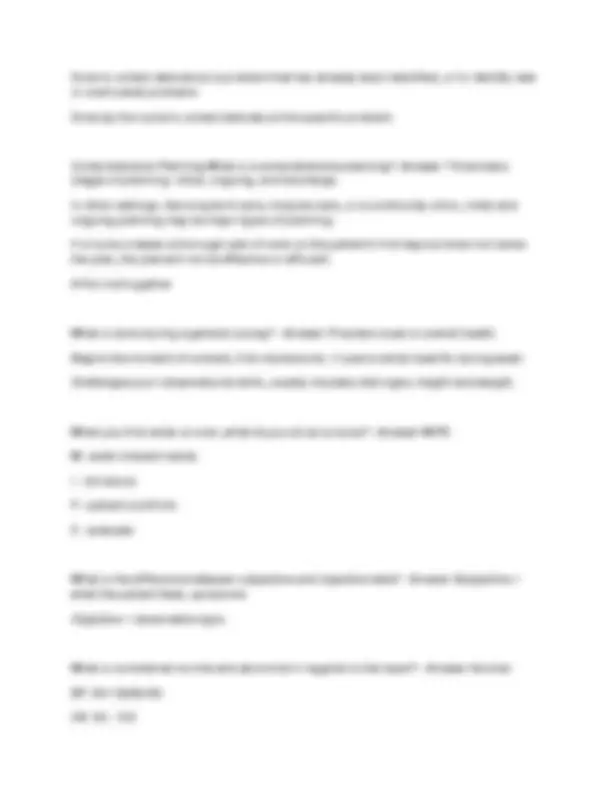
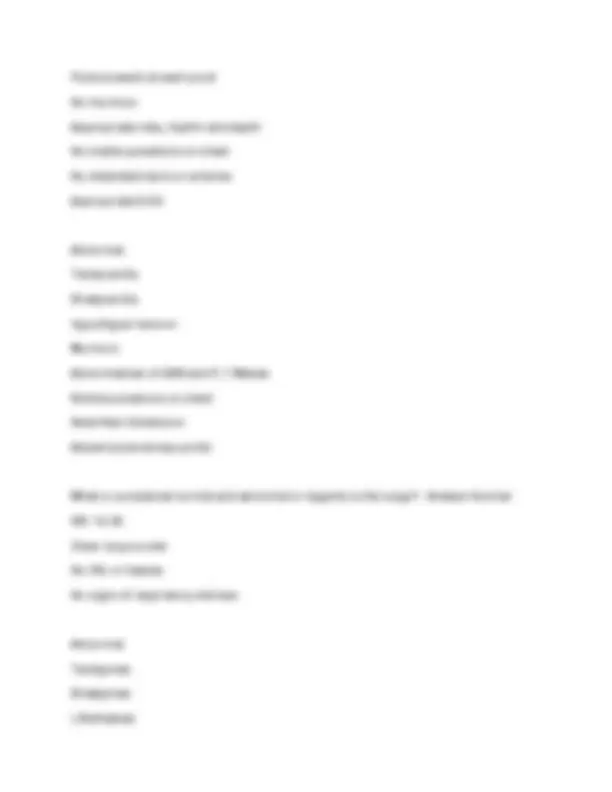

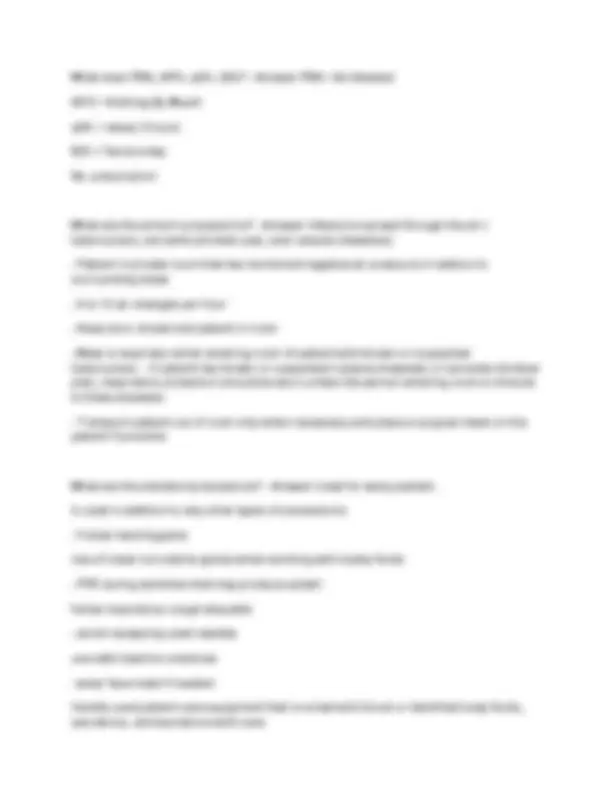
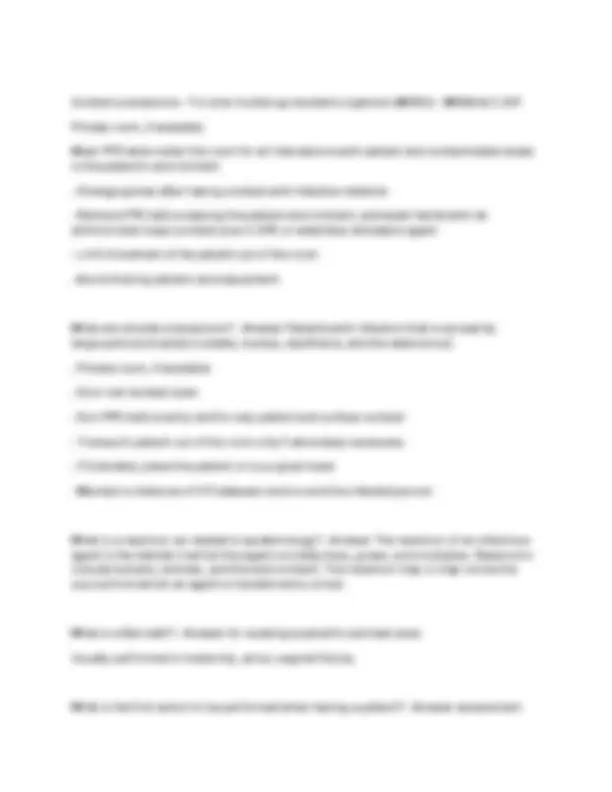
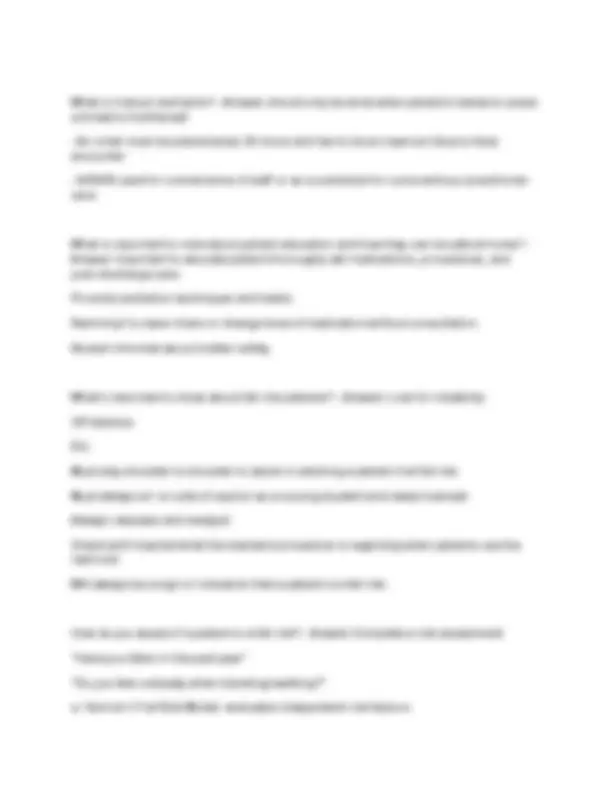
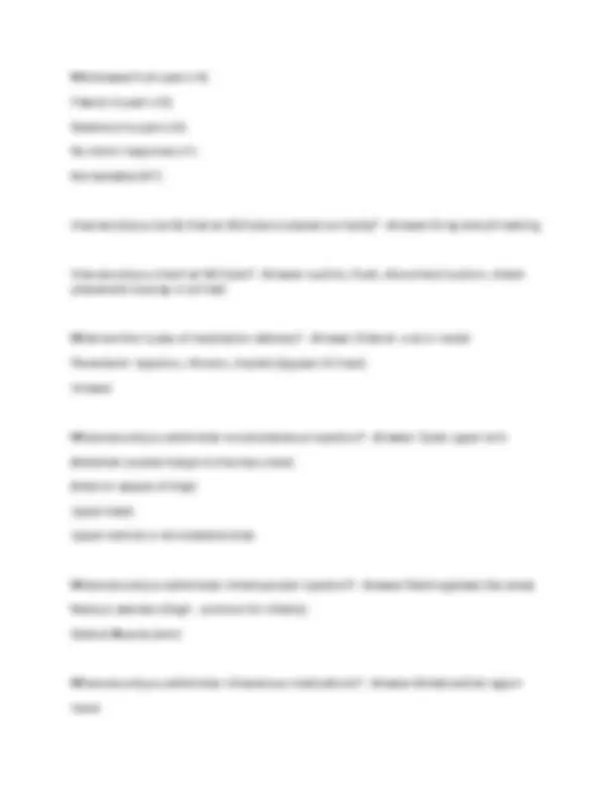
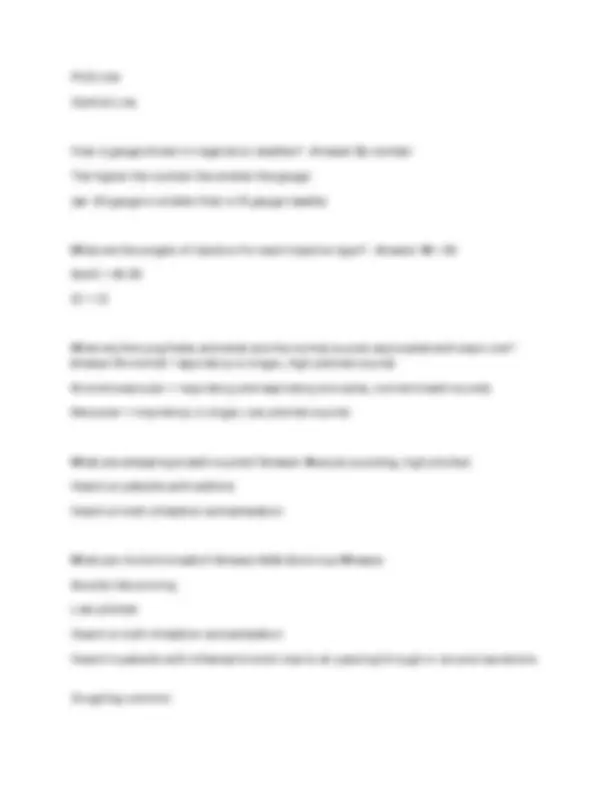
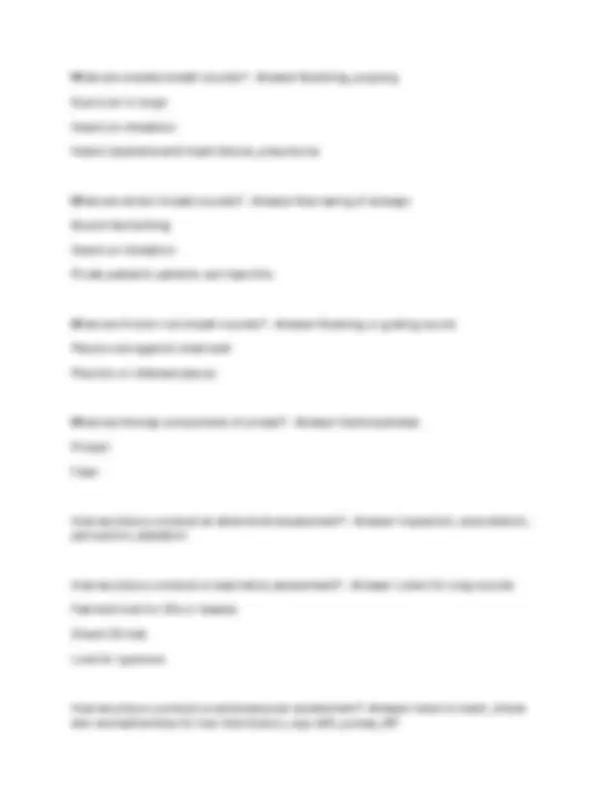
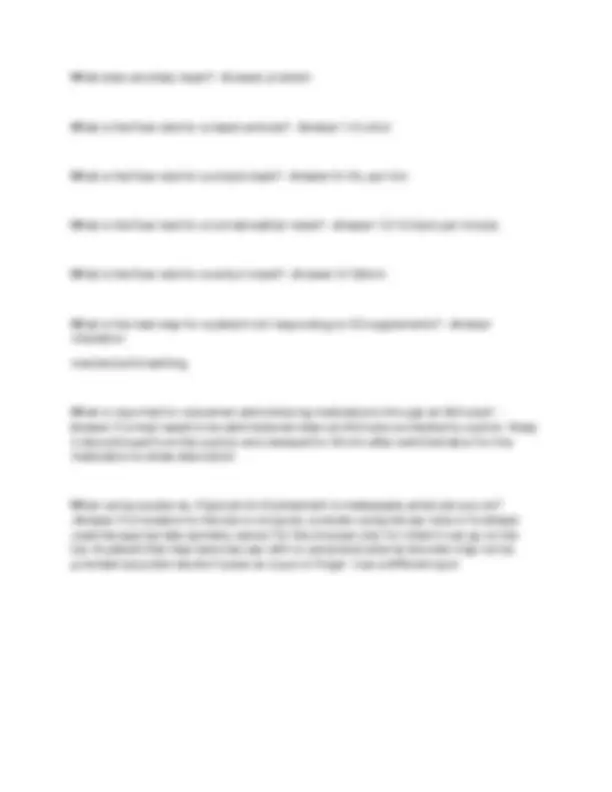


Study with the several resources on Docsity

Earn points by helping other students or get them with a premium plan


Prepare for your exams
Study with the several resources on Docsity

Earn points to download
Earn points by helping other students or get them with a premium plan
Community
Ask the community for help and clear up your study doubts
Discover the best universities in your country according to Docsity users
Free resources
Download our free guides on studying techniques, anxiety management strategies, and thesis advice from Docsity tutors
A comprehensive review of key concepts and principles in nursing, focusing on patient care, assessment, and vital signs. It includes questions and answers covering topics such as maslow's hierarchy of needs, the nursing process, hypoxia, and infection control. Valuable for nursing students preparing for their final exam, offering a concise and organized overview of essential nursing knowledge.
Typology: Exams
1 / 18

This page cannot be seen from the preview
Don't miss anything!











What are Maslow's Hierarchy of Needs? -Answer 1. physiological needs: water, O2, sleep
What are the ABC's of physiological needs? -Answer A - airway B - breathing C - circulation D - disability/ability E - Exposure *time will determine which to prioritize what is happening rn
What are the components of the nursing process (Tanners Judgmental Model)? - Answer ADPIE Assess = recognize cues; collecting data (subjective, objective) Diagnosis = building on data; nursing diagnosis ex: imparied gas exchange Prepare = patient centered; prioritize w/ safety and ABC's to create a care plan Implement = action; interventions to adjust prioritized problems Evaluate = patient centered SMART; did we meet our goals
What are SMART goals? -Answer Specific, Measurable, Attainable, Realistic, Timely
What are the components of a patients health history?-Answer SAMPLE S- signs and symptoms A- allergies M- medications P - past medical history L - last meal (last bowel movement) E- events (why are they here today)
What is hypoxia?-Answer deficiency in the amount of oxygen reaching the tissues < 90% SpO
What are the early symptoms of hypoxia? - Answer (RAT) R- restlessness A - anxiety T - tachycardia, tachypnea
What are the late symptoms of hypoxia? - Answer (BED) B - bradycardia E - extreme restlessness D - dyspnea
What is an initial assessment? - Answer Performed shortly after admittance to a healthcare facility. Establishes a complete database for problem identification and care planning Performed by the nurse (baseline data)
Focused Assessment What is a focused assessment? -Answer May be done in initial assessment or as routine ongoing data collection.
Pulse present at each point No murmurs Appropriate rate, rhythm and depth No visible pulsations on chest No distended veins or arteries Appropriate ECG
Abnormal: Tachycardia Bradycardia Hypo/Hyper tension Murmurs Abnormalities of QRS and P, T Waves Visible pulsations on chest Neck Vein Distension Absent pulse at any points.
What is considered normal and abnormal in regards to the lungs? - Answer Normal: RR: 12- Clear lung sounds No lifts or heaves No signs of respiratory distress
Abnormal: Tachypnea Bradypnea Lifts/heaves
Nasal flair Use of accessory muscles Tripod breathing Wheezing/stridor/cough/crackles, etc. What is considered normal and abnormal in regards to the skin? - Answer Normal: Cap refill <3sec No ecchymoses, bruising, erythema, cyanosis, etc. Normal temp Normal humidity Normal Skin turgor
Abnormal: Cap refill >3 sec Bruising, pressure ulcers, skin breakdown, erythema, cyanosis, jaundice, absent skin turgor- positive tenting ANALGESIA What is normal and abnormal in relation to the renal system? Normal: 30mL of urine out Normal yellow color No hematuria No protein, ketones, glucose Voluntary No discomfort
Abnormal
or <30 mL Dark orange, red, clear, color
Blood Pressure O2 Stat
What are normal ranges for the primary vital signs? - Answer Temp: 97- HR: 60- RR: 12- BP: 90/60 - 120/ O2 Stat: >90%
What is orthostatic (postural) hypotension? - Answer Decrease in both systolic and diastolic blood pressure upon standing Lack of normal blood pressure compensation in response to gravitational changes on the circulation
Name of tool used to take blood pressure and why is it important to use the right size cuff. - Answer Sphygmomanometer Stethoscope Too Tight: Inaccurately high BP Too Loose: Inaccurately low BP
What causes Hypertension? - Answer Stress Exercise Infection
When blood volume is great compared to space available inside blood vessels
What causes hypotension? - Answer Dehydration, volume loss in blood, medication, heart failure
What does PRN, NPO, q2hr, BID? - Answer PRN = As Needed NPO = Nothing By Mouth q2hr = every 2 hours BID = Twice a day Rx: prescription
What are the airborn precautions? - Answer Infections spread through the air ( tuberculosis, varicella (chicken pox), and rubeola (measles))
What are the standard precautions? - Answer Used for every patient. Is used in addition to any other types of precautions.
What is it about restraints? - Answer should only be done when patient's behavior poses a threat to him/herself
What is important to note about patient education and how they can be safe at home? - Answer Important to educate patient thoroughly abt medications, procedures, and post-discharge care. Promote sanitation techniques and habits. Remind pt to never share or change dose of medication without consultation. Be well informed about toddler safety.
What's important to know about fall risk patients? - Answer Look for instability Off balance Etc. Must stay shoulder to shoulder to assist in catching a patient if at fall risk Must always err on side of caution as a nursing student and newly licensed Always reassess and readjust Check with hospital what the standard procedure is regarding when patients use the restroom Will always be a sign or indication that a patient is a fall risk.
How do you assess if a patient is a fall risk? - Answer Complete a risk assessment "Have you fallen in the past year" "Do you feel unsteady when standing/ walking?" a. Henrich II Fall Risk Model- evaluates independent risk factors
B. Morse Fall Scale- 6 questions to identify risk for falls
Causes of Falls outside of Hospitals- Main cause of falls in patients' homes is ill-fitting shoes Physical hazards such as throw/area-rugs (type of rug easily picked up and moved) Poor lighting Transitioning to different terrain. ex. sidewalk/asphalt to bricks
What is important to know about fire safety? - Answer RACE Rescue anyone in immediate danger.
Activate the fire code system and notify the appropriate person.
Confine the fire by closing doors and windows, (limits the spread of smoke).
Move patients and others to safety R.A.C.E.
What are the major positions that a patient can be placed in and what is the associated skill with it? - Answer Fowlers = half seated 45 - 90 degrees Semi-fowlers = 30-45 degrees half seated, laying down Sims = per-rectal examinations. pt lays on left side with their right knee slightly flexed and tilted. Supine = fully laying down
How do you lift a box? Using your knees and your legs, not your back
What are the different types of exercises? Isotonic = ADL, active movement, range of
Withdrawal from pain (+4) Flexion to pain (+3) Extension to pain (+2) No motor response (+1) Not testable (NT)
How would you verify that an NG tube is placed correctly? - Answer X-ray and pH testing
How would you insert an NG tube? - Answer suction, flush, disconnect suction, check placement via xray or pH test
What are the routes of medication delivery? - Answer Enteral: oral or rectal Parenteral: injection, infusion, implant (bypass GI tract) Inhaled
Where would you administer a subcutaneous injection? - Answer Outer upper arm Abdomen (costal margin to the iliac crest) Anterior aspect of thigh Upper back Upper ventral or dorsolateral area
Where would you administer intramuscular injection? - Answer Ventrogluteal (hip area) Vastus Lateralis (thigh - common for infants) Deltoid Muscle (arm)
Where would you administer intravenous medications? - Answer Antebrachial region Hand
PICC line Central Line
How is gauge shown in regards to needles? - Answer By number The higher the number the smaller the gauge. (ex: 24 gauge is smaller than a 18 gauge needle)
What are the angles of injection for each injection type? - Answer IM = 90 SubC = 45- ID = 15
What are the lung fields and what are the normal sounds associated with each one? Answer Bronchial = expiratory is longer, high pitched sounds Bronchovesicular = inspiratory and expiratory are same, normal breath sounds Vesicular = inspiratory is longer, low pitched sounds
What are wheezing breath sounds? Answer Musical sounding, high pitched Heard on patients with asthma Heard on both inhalation and exhalation
What are rhonchi breaths? Answer AKA Sonorous Wheeze Sounds like snoring Low-pitched Heard on both inhalation and exhalation Heard in patients with inflamed bronchi due to air passing through or around secretions
Coughing common
How would you conduct a peripheral vascular assessment? -Answer Check cap refill Look for jaundice Test skin turgor Check for pressure ulcers Check for edema
What is polyuria? -Answer excessive urination
What does aging do to the body? - Answer - Thinner, less elastic skin; wrinkles.
What is continence and incontinence? - Answer Continent: control of elimination Incontinent: not control of elimination
What are the types of diets? - Answer fat-restricted diet high-fiber diet low-fiber diet renal diet clear liquid diet pureed diet mechanically altered NPO diet
What is basal metabolic rate? - Answer the energy (number of calories) required to fuel the involuntary activities of the body at rest after a 12-hour fast
What factors that affect an individuals basal metabolic rate? - Answer Factors that increase BMR: growth, infection, fever, elevated hormones Factors that decrease BMR: Sleep and age
What does skin turgor show you about the patient? - Answer Decrease skin elasticity and dehydration if tenting is present after pinching skin
What is another term for reflection after an assignment? - Answer evaluation